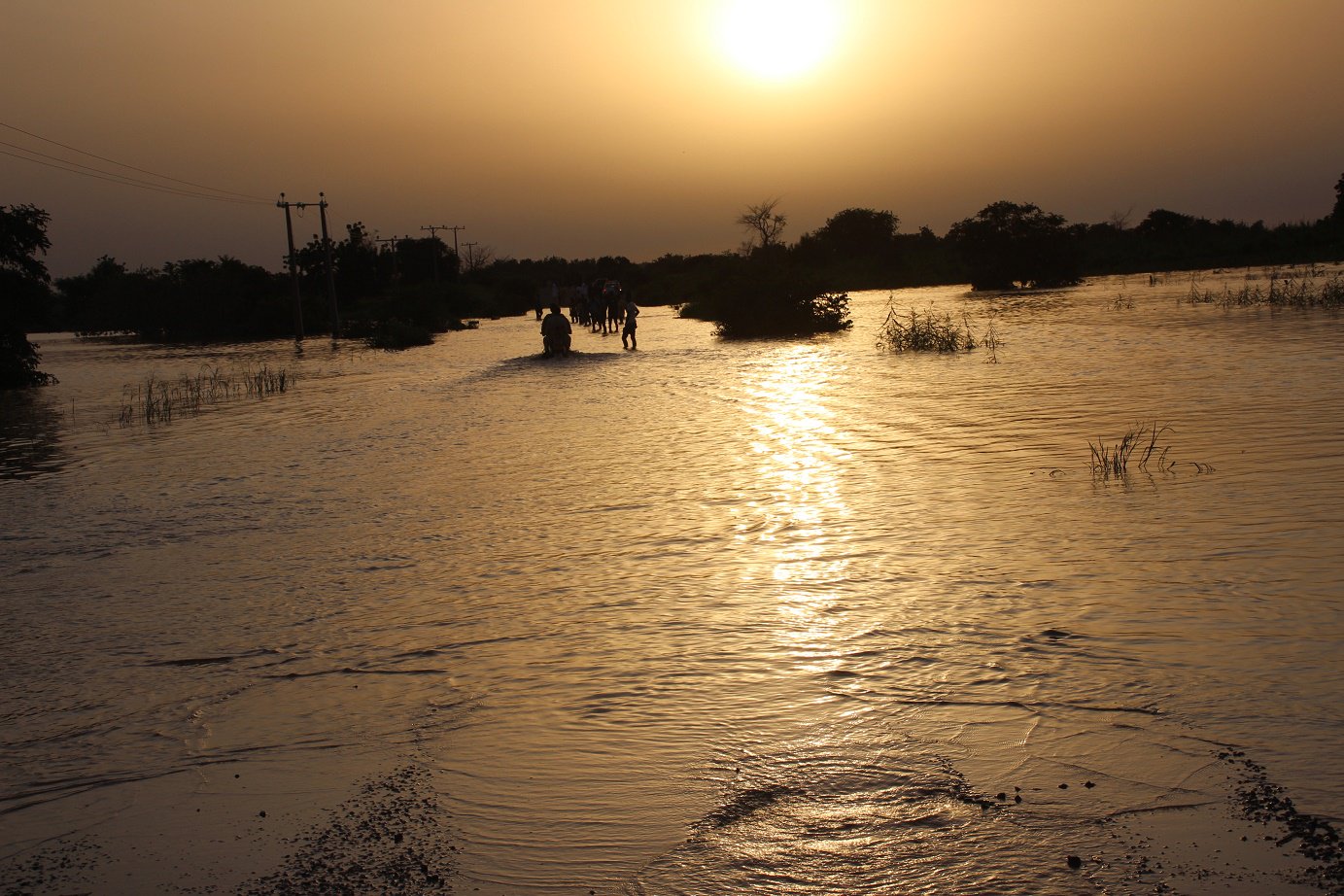Like Makurdi, like Houston, what are the hurricanes telling us?

The past month has been particularly stormy and devastating around the world. From Makurdi in Nigeria’s Benue State, to Houston, Texas in the United States, and a large swathe of the Caribbean have been left drenched and battered by torrential rains and record level hurricanes.
For several days earlier this month, the heavens opened up and poured non-stop in Makurdi and environs. Unfortunately, many residents of the town were caught napping. This has led to a lot of finger pointing. While the government said it warned people of the coming rains, residents said they were not warned. The rains however, were not interested in the buck passing game, and in a matter of days properties and farmland worth billions of naira lay either submerged or washed away.
When the rains stopped, over 110,000 people were rendered homeless. Three thousand houses across 24 communities were affected by the flooding, and at least four people died from possible water borne diseases.
Like Nigeria, like the Western Hemisphere: A state of unpreparedness
Nigeria is perennially unprepared for emergencies just like this. Clearly, the country learned very little, if anything, from the 2012 flooding of the town when water was released from the Ladjo Dam in Cameroon, and causing the River Benue, on whose banks Makurdi sits, to overflow.
Displaced people were huddled into stalls in a previously redundant International Market, in Makurdi four families to a stall. People grumbled about the government’s unpreparedness and corruption – food and other suppliers were either not provided, inadequate or allegedly stolen by officials. Others who could not make it into the government-run shelter (The market spoken of above is the shelter) were catered for in other shelters run by non-governmental organisations.
According to the 2017 Seasonal Rainfall Prediction (SRP) of the Nigerian Meteorological Agency (NiMet) more rainfall is to be expected around the North Central before the the cessation of period of October.
Worse, there are no assurances that Cameroon will not open the Ladjo Dam again thereby flooding the already saturated Benue River. The government is already talking about building drainages and clearing houses and other structures blocking water channels.
“We do not have a choice but to embark on demolition of illegal structures and buildings on water ways and drainages, if this matter must be addressed appropriately so that people do not continue to suffer in this manner. Given the magnitude of the situation at hand, we call on the Federal Government to urgently intervene in the problem because the flood has rendered many residents of Makurdi town homeless,” said Governor Samuel Ortom.
But these are merely measures. To solve the flooding problem permanently, the government must dredge the Benue River to enable it contain more flood water. The state will need an estimated ₦308 billion to pull that off.
“Benue Government is looking for ways in which River Benue can be dredged. This is because by dredging the river, majority of the water can be accommodated to prevent future overflow,” said Joseph Ustev, the state’s commissioner of Water Resources and Environment.
“The ongoing research so far, showed that the preliminary study will cost about N8 billion while the main project will gulp about N300 billion.
“This is where we need federal government financial intervention to execute the project, since the funds are much.”
Benue’s internally-generated revenue of about ₦250 million and the roughly ₦3 billion it gets as federal allocation every month is hardly enough to carter of for displaced people and take care of other issues in the state requiring urgent attention.
The Federal Government, has however, promised to help.
“We need to look at a realistic solution to this problem, the dredging of River Benue is very important in addressing this flood issue and we will do something about it,” President Muhammadu Buhari said.
“The intention of the Federal Government is not just to assist flood victims but also to find ways of providing real opportunities to help Nigerians improve their standard of living.”
Benue prides itself as the food basket of the nation. In one of Nigeria’s ironies, the largely agrarian state is perhaps one of the poorest in the country. Like in 2012 where the flood left miles and miles of farmland of crops especially maize, vegetable, millet, groundnut beans and yam in ruins, this year’s flood will certainly have a devastating effect of next harvest.
The American angle
Interestingly enough, the story was not different across the Atlantic. Hurricane Harvey, which at Category 4, was measured in the second highest storm classification, made landfall in Houston Texas, submerging who communities and destroying properties worth billions of dollars. According to some analysts, the hurricane is in competition for the costliest hurricane in US history. AccuWeather, the world’s première weather forecasting portal, said that the hurricane has an economic cost to the US of nearly $190 billion, which is the combined cost of Hurricane Katrina (2005) and Hurricane Sandy (2012).
There is more. More than 500,000 cars and trucks were destroyed in the hurricane. The largest refinery in the US owned by Saudi affiliated Motiva Enterprises, which produces more than 600,000 barrels a day was shut down. As Harvey petered away in Houston, Hurricane Irma made landfall in Keys, Florida rendering over 10,000 people homeless.
Earlier this week, the US National Hurricane Centre predicted that Hurricane Maria which had devastated Dominica, in the Caribbean had picked up speed and regained strength into a category 5 hurricane after briefly dropping to category 4. The centre stated that the hurricane was expected to reach the Virgin Islands and Puerto Rico by Wednesday.
Guadeloupe, another Caribbean Island, which was used as a refuge for victims of Hurricane Irma, was devastated by Hurricane Maria.
No fewer than 20 people have been reported killed by the high-speed storm in the Caribbean last week as houses and other properties destroyed.
“Everything is destroyed, every building has received damage; it’s been catastrophic,” Darrell Gumbs, a constable in the Royal Anguilla Police Force, told the New York Times. He said the damage as “total devastation. “
“This season has been an overachiever by almost every index,” said Bob Hedson, a meteorologist for Weather Underground, a forecasting service.
“We’ve had more than a year’s worth of named storms when you look at the long-term average, and that’s being just past the midpoint of the season,” he said to the New York Times.
Signs of Global Warming
Individually these storms appear to be normal but when taken together while factoring the closeness of their occurrence they should be a major source of worry not only for climate enthusiasts but for everybody.
In 2014, the US National Climate Assessment (NCA) reports that the frequency of strong hurricane points to a warmer climate.
“The intensity, frequency, and duration of North Atlantic hurricanes, as well as the frequency of the strongest (Category 4 and 5) hurricanes, have all increased since the early 1980s. The relative contributions of human and natural causes to these increases are still uncertain. Hurricane-associated storm intensity and rainfall rates are projected to increase as the climate continues to warm,” it stated in its report.
Jay Gulledge, an adviser for the Centre for Climate and Energy Solutions (C2ES), explained further: “All of them (hurricanes) required an enormous source of atmospheric moisture to generate such extreme rainfall totals in a matter of hours to days,” he explained in an article written in the wake of Hurricane Harvey.
“That moisture source is no mystery: It is the warm tropical waters of the North Atlantic (principally the Gulf of Mexico) and eastern Pacific oceans. These bodies of water have been warming over recent decades and are evaporating more and more moisture into the atmosphere along the Gulf and Atlantic Coasts. The atmosphere is also warming, and warmer air holds more water vapour. As the climate warms, therefore, more moisture becomes available to supply rainfall.
“This fact is basic physics and there isn’t any real uncertainty about it. Moreover, it is well understood that the oceans and atmosphere are warming as a direct result of man-made greenhouse gas emissions. (Without those emissions, the climate system would actually be cooling slightly).
“So what does Hurricane Harvey tell us about climate change? It confirms that our risk is rising as the climate warms. Harvey also teaches us about our vulnerabilities and adaptation needs.”
While governments around the world are preparing on how to limit the human and material cost of to hurricanes and torrential rainfalls when they occur, people need to reassess our relationship with the environment as much of the cause of global warming are man-made.
Immediate danger looms
Tellingly, just a week ago, the Director General of the National Emergency Management Agency, NEMA, Engr. Mustapha Y. Maihaja FNSE called on residents along the River Niger and its tributaries in Kebbi, Niger, Kogi, Anambra, Delta, Imo, Rivers and Bayesla states to be on the alert of very high risk of catastrophic flooding soon.
The Nigeria Hydrological Services Agency (NIHSA) had warned of the rising water levels in Niger, which confluences with the Benue River at Lokoja, the capital of neighbouring Kogi state. The warning was put at “Orange Alert level”, and has been there for at least two weeks now.
“The Orange Alert is the second most severe category in measurement. As such, those living in the mention states should prepare for any eventuality,” Maihaja said.
Following this year’s seasonal rainfall forecast by Nigerian Meteorological Agency (NIMET) in March 2017 and hydrological outlook by the Nigeria Hydrological Services Agency (NIHSA) of possible flood that will affect many States of the Federation, the National Emergency Management Agency (NEMA) sent out alert warning to identified States and called them to scale-up their preparedness to avert imminent consequences.
NEMA said as a result of that warning, already, twenty seven (27) States have experienced very devastating flood disaster.








